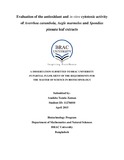| dc.contributor.advisor | Choudhury, Dr. Naiyyum | |
| dc.contributor.advisor | Ahsan, Dr. Chowdhury Rafiqul | |
| dc.contributor.author | Zaman, Anahita Tanzia | |
| dc.date.accessioned | 2015-05-26T04:54:52Z | |
| dc.date.available | 2015-05-26T04:54:52Z | |
| dc.date.issued | 2015-04 | |
| dc.identifier.other | ID 11276010 | |
| dc.identifier.uri | http://hdl.handle.net/10361/4149 | |
| dc.description | This thesis report is submitted in partial fulfillment of the requirement for the degree of Masters of Science in Biotechnology, 2015. | en_US |
| dc.description | Cataloged from PDF version of thesis report. | |
| dc.description | Includes bibliographical references (page 79-85). | |
| dc.description.abstract | Three typically grown Bangladeshi fruit trees, Averrhoa carambola L, Spondias pinnata and
Aegle marmelos possess various therapeutically important properties and their different parts
have been experimented for antioxidant and cytotoxicity activities in various studies.
Antioxidants help prevent free radicals from harming our body with various degenerative
diseases by donating electrons. Antioxidants neutralize the free radicals and reduce the damage
in cells before oxidants can attack. The objective of this study was to evaluate the three fruit
plants leaf extracts and to find their antioxidant content and also In vitro cytotoxic activity using
HeLa cell line. This study may allow us to get a comprehensive analysis on their individual
activities and show susceptible results which will help in further research prospective. As they
are typically grown in Bangladeshi environment and are readily available, they can be screened
to find out which of them contain the highest amount of antioxidant and cytotoxic properties.
Dried powdered leaves of Averrhoa carambola L, Spondias pinnata and A. marmelos were
extracted using a Soxhlet apparatus using, n-hexane, petroleum ether, methanol and chloroform.
The extracts were tested for CUPRAC reducing capacity, total antioxidant capacity, total
phenolic content and total flavonoid content. Cytotoxic analysis was done using HeLa cell line
and cell viability was checked. All three methanolic leaf extracts of the fruits plants showed the
highest CUPRAC reducing capacity when compared against the standard (BHT). For both
Averrhoa carambola L and A. marmelos, petroleum ether extract showed the highest antioxidant
content; 105.8mg/gm, 89.4mg/gm; n-hexane extract showed the highest phenol content;
212.4mg/gm, 686mg/gm and methanol extract showed the highest flavonoid content;
171.6mg/gm, 146mg/gm. For Spondias pinnata, chloroform extract showed the highest total
antioxidant content; 122mg/gm, petroleum ether extract showed the highest phenol content;
280.6mg/gm and methanol extract showed the highest flavonoid content; 189.5mg/gm. In vitro
cytotoxicity test revealed that all extracts of A. marmelos showed <1% viability of HeLa cells,
followed by Averrhoa carambola L extracts, while Spondias pinnata extracts showed the least
cell death. It can be suggested that both Averrhoa carambola L and A. marmelos extracts showed
promising results than Spondias pinnata and they can be further analysed in a more diverse
manner. | en_US |
| dc.description.statementofresponsibility | Anahita Tanzia Zaman | |
| dc.format.extent | 85 pages | |
| dc.language.iso | en | en_US |
| dc.publisher | BRAC University | en_US |
| dc.rights | BRAC University thesis are protected by copyright. They may be viewed from this source for any purpose, but reproduction or distribution in any format is prohibited without written permission. | |
| dc.subject | Biotechnology | en_US |
| dc.title | Evaluation of the antioxidant and in vitro cytotoxic activity of Averrhoa carambola, Aegle marmelos and Spondias pinnata leaf extracts | en_US |
| dc.contributor.department | Department of Mathematical and Natural Science, BRAC University | |
| dc.description.degree | M. Biotechnology | |

